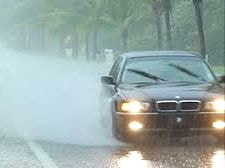Driving skills in storms
 |
| Things to note when driving in storms |
Trying to run at high speed in a storm is absolutely not recommended, risks can come from the simplest situations.
Storms often occur in Vietnam, but in the past there were few highways so even if drivers wanted to, they could not drive fast because of traffic jams. But now there are more highways and national highways have been upgraded to be more beautiful, so drivers need to improve their driving skills on highways in storms. Below are some skills that my friends and I learned one day when we stopped at a rest stop to have a cup of coffee and wait for the rain and wind to stop before continuing.
1. Always keep up to date with the weather
Television, newspapers and even weather fanpages on Facebook also regularly update weather conditions. For drivers planning long-distance trips, update the weather not only on the departure day but also on the return day and the surrounding days, because long rains before the departure day can affect the quality of the road surface such as flooding or landslides in mountainous areas.
Ideally, if the weather is bad and the work is not urgent, everyone should reschedule to a dry day. If not, prepare everything carefully from point 2 below.
2. Prepare supplies for rainy days
In the car, there should be a triangle warning sign and a few cones ready to be placed around the car, warning other cars from a distance to be ready to avoid. In addition, there should be items such as umbrellas, raincoats, flashlights, boots... because you may have to rush out in the rain to check the condition of the car, or even leave the car and walk to a safe place.
Food and water are also needed. Prolonged rain can cause traffic jams and landslides that make it impossible to continue and require a long wait. Drivers should prepare dry food and water, which can provide enough energy in the simplest way.
3. Car repair tools
To be a good driver, everyone behind the wheel should know basic repair techniques such as changing a spare tire, checking and adding coolant, oil, or more complex things like jump-starting a dead battery with another car's battery.The car should have a basic repair kit such as a mini jack, wrench, screwdriver, pliers, a lever to open the wheel bolts...
4. Driving in the rain
- Slow down: If you have to continue driving in heavy rain and strong winds to keep up with the schedule, remember that the first thing to do is to slow down to a safe level. Heavy rain comes with reduced visibility, slippery roads, loss of traction, puddles, muddy water... so slow down to be ready to deal with unexpected situations.
- Turn on the lights: When the rain is too heavy, the effect of the windshield wipers is significantly reduced. At this time, observing the vehicle in front becomes difficult, no different from a foggy road. Turn on the low beams, fog lights and even the emergency lights to flash both turn signals, attracting the attention of the vehicle behind. Of course, don't forget to turn on the turn signal every time you need to turn.
- Avoid flooded roads: Flooded roads pose many dangers. It is difficult for drivers to visually monitor the depth of the water ahead, so if you are unsure, follow the car in front. If there is no car in front, you can get out of the car and try to measure the water level with anything you can, such as a tree branch on the side of the road, or even wade in.
- Do not tailgate: Even if you have reduced your speed to a level where you feel you can control the situation, do not tailgate the car in front. Rain reduces the stopping distance and steering angle, so if the car in front suddenly brakes or avoids an obstacle, you may get caught because you tailgate too closely and cannot avoid it.
- Limit lane weaving: Many drivers tend to want to drive faster to get home when it's raining and use lane weaving like "roasting peanuts". Driving like this can cause you to lose control, which is dangerous for you, and can also cause other cars to be startled and brake suddenly or swerve.
- Water film: Rainwater or any liquid that is poured onto the road in large quantities, causing the road surface to not drain quickly, creates a thin film, separating the wheels from the road surface. The thicker this film is, the less grip the wheels have, increasing the possibility of losing control.
To cope, when driving on the highway in the rain, drivers should turn off all music and listen. If the rain is so heavy that the sound of tires rubbing against the road surface cannot be heard, it means that the water film is very thick, and even a few sudden steering movements can be dangerous. Pay attention to listen to drive most safely.
At the same time, you should observe the water roll from the front wheel, the more water spray, the more water on the road surface. If there is no more water spray but turns into streams, then the road is very wet, reduce speed immediately if you do not want to slip.
Above are the experiences that my friends and I shared. Readers and drivers who have more experiences, please contribute so that everyone can drive more safely. Have a safe trip!
According to VNE
| RELATED NEWS |
|---|

